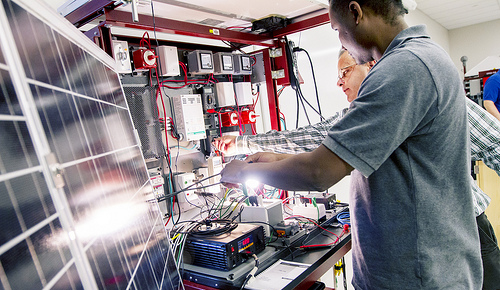
Technological change directed towards more efficient and eco-friendly technologies is a priority for both developed and developing countries. Insights on past trends and determinants of energy innovation are important to set the basis for cost-effective climate and energy policies in the coming years.
But what is energy innovation? Defining the issue is challenging, clearly defining which innovations improve energy consumption and usage in an economy is even more so. These issues are made more complicated by the fact comprehensive statistics on energy-related innovation are not readily available. However, issues such as the role of institutions, as enabling or inhibiting factors, and of lobbying as a barrier to clean energy transitions, are important factors that have been only marginally examined by the existing literature.
The paper “The political economy of energy innovation” (authored by CMCC researchers Shouro Dasgupta, Enrica De Cian, and Elena Verdolini) investigates the effects of environmental policy, institutions, political orientation, and lobbying on energy innovation.
First, the study provides an overview of the different proxies for energy-related innovation, which we define as innovation aimed at improving energy efficiency and/or at reducing carbon intensity of energy, such as renewables and more efficient power-generating technologies. More in detail, researchers compiled information on two of the commonly used indicators of innovation, namely energy industrial Research and Development (R&D), which measure innovation inputs, and energy patents, which measure innovation outputs while describing their dynamics using a panel dataset of 20 countries over the years 1995–2010.
The collected data were used to analyze the influence of political economy factors on energy-related innovations. The study focused on four different aspects: the types and stringency of government support to energy innovation (e.g. the various policy instruments implemented to this end such as environmental and R&D policies); the quality of governance (e.g. government effectiveness and rule of law); the political orientation of the government; and the distribution of resources across interest groups.
The study highlighted that all institutional and political economy factors affect the incentives to innovate and create cleaner energy efficient technologies. Overall, results suggest that political economy factors may act as barriers even in the presence of stringent environmental policy. To move towards a greener economy, countries should combine environmental policy with a general strengthening of institutional quality, consider the influence of government’s political orientation on environmental policies, and the implications of the size of energy intensive sectors in the economy.
Read and download the integral version of the paper “The political economy of energy innovation”:
Dasgupta S., De Cian E., Verdolini E.
The Political Economy of Energy Innovation
2017, The Political Economy of Clean Energy Transitions, DOI: 9780198802242
The book “The Political Economy of Clean Energy Transitions” exploring the unprecedented era of policy experimentation generated by COP21 in driving a clean energy transition. A compendium of what has been learned from recent initiatives, mostly (but not exclusively) at country level, to reduce GHG emissions.


